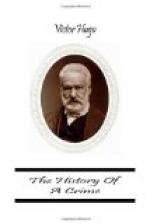As they reached the point where the Streets Ste. Marguerite and de Cotte open out and divide the Faubourg, a peasant’s cart laden with dung entered the Rue Ste. Marguerite.
“Here,” exclaimed De Flotte.
They stopped the dung-cart, and overturned it in the middle of the Faubourg St. Antoine.
A milkwoman came up.
They overturned the milk-cart.
A baker was passing in his bread-cart. He saw what was being done, attempted to escape, and urged his horse to a gallop. Two or three street Arabs—those children of Paris brave as lions and agile as cats—sped after the baker, ran past his horse, which was still galloping, stopped it, and brought back the cart to the barricade which had been begun.
They overturned the bread-cart.
An omnibus came up on the road from the Bastille.
“Very well!” said the conductor, “I see what is going on.”
He descended with a good grace, and told his passengers to get down, while the coachman unharnessed his horses and went away shaking his cloak.
They overturned the omnibus.
The four vehicles placed end to end barely barred the street of the Faubourg, which in this part is very wide. While putting them in line the men of the barricade said,—
“Let us not injure the carts more than we can help.”
This formed an indifferent barricade, very low, too short, and which left the pavements free on either side.
At this moment a staff officer passed by followed by an orderly, saw the barricade, and fled at a gallop.
Schoelcher calmly inspected the overturned vehicles. When he reached the peasant’s cart, which made a higher heap than the others, he said, “that is the only good one.”
The barricade grew larger. They threw a few empty baskets upon it, which made it thicker and larger without strengthening it.
They were still working when a child came up to them shouting, “The soldiers!”
In truth two companies arrived from the Bastille, at the double, through the Faubourg, told off in squads at short distances apart, and barring the whole of the street.
The doors and the windows were hastily closed.
During this time, at a corner of the barricade, Bastide, impassive, was gravely telling a story to Madier de Montjau. “Madier,” said he, “nearly two hundred years ago the Prince de Conde, ready to give battle in this very Faubourg St. Antoine, where we now are, asked an officer who was accompanying him, ‘Have you ever seen a battle lost?’—’No, sire.’ ’Well, then, you will see one now.’—Madier, I tell you to-day,—you will speedily see a barricade taken.”
In the meanwhile those who were armed had assumed their places for the conflict behind the barricade.
The critical moment drew nigh.
“Citizens,” cried Schoelcher, “do not fire a shot. When the Army and the Faubourgs fight, the blood of the People is shed on both sides. Let us speak to the soldiers first.”




